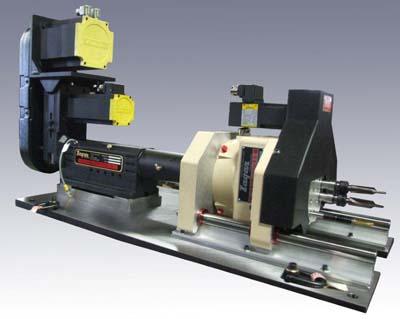
Zagar Inc. has introduced an updated version of their most popular feed unit, the Model MQ-150. The redesigned unit is a full servo driven ball screw feed design that incorporates the unique feature of having the quill and spindle assembly located inside a pre-drilled, precision bored ball screw. The new "in-line" design provides what is thought to be one of the most accurate feed units on the market, having a stroke repeatability of +/-0.0001".
The MQ-150 Feed Unit can be used with standard tooling to provide single drilling, tapping, counter boring, and reaming operations. It can also be combined with a Zagar Multiple Spindle Head to increase productivity and perform these types of operations on various part locations with one feed unit stroke. With 5 HP brushless servo motors and a 6 inch stroke, the Model MQ-150 provides 2,000 lbs. of thrust using a 2.17" diameter quill. The spindle has a maximum of 10,000 RPM with a rapid traverse of 800 IPM. Most common spindle nose adapters can be used from a collet chuck holder to HSK type tool holders.
The Model MQ-150 has its' own enclosed control cabinet built to NEMA 12 standards. Brushless servo motors are used for feed rate and RPM control. User friendly software provides easy operator use to input spindle stroke, feed rate, RPM, and drilling or tapping sequences. The built-in PLC is compatible with multiple auto cycling and automatic changeover between stored machining sub-routines. The software provides for peck drilling cycles, rigid tapping, left or right hand drapping cycles which are a combination of drilling and tapping. Adjustable feed and retract stops are provided. The new Zagar design provides for coolant through the spindle at up to 1500 lbs. of pressure. The unit can be mounted in a vertical or horizontal position or at an angle. The MQ-150 can also be provided with a quick change, ball lock mounting plate for easy changeover to various part applications.
The new MQ-150 feed Unit can be purchased with its' own column mounting option to form a single or multiple spindle drill/tap station or it can be used for in-line and rotary transfer type of high production machines.
Contact Details
Related Glossary Terms
- boring
boring
Enlarging a hole that already has been drilled or cored. Generally, it is an operation of truing the previously drilled hole with a single-point, lathe-type tool. Boring is essentially internal turning, in that usually a single-point cutting tool forms the internal shape. Some tools are available with two cutting edges to balance cutting forces.
- chuck
chuck
Workholding device that affixes to a mill, lathe or drill-press spindle. It holds a tool or workpiece by one end, allowing it to be rotated. May also be fitted to the machine table to hold a workpiece. Two or more adjustable jaws actually hold the tool or part. May be actuated manually, pneumatically, hydraulically or electrically. See collet.
- collet
collet
Flexible-sided device that secures a tool or workpiece. Similar in function to a chuck, but can accommodate only a narrow size range. Typically provides greater gripping force and precision than a chuck. See chuck.
- coolant
coolant
Fluid that reduces temperature buildup at the tool/workpiece interface during machining. Normally takes the form of a liquid such as soluble or chemical mixtures (semisynthetic, synthetic) but can be pressurized air or other gas. Because of water’s ability to absorb great quantities of heat, it is widely used as a coolant and vehicle for various cutting compounds, with the water-to-compound ratio varying with the machining task. See cutting fluid; semisynthetic cutting fluid; soluble-oil cutting fluid; synthetic cutting fluid.
- feed
feed
Rate of change of position of the tool as a whole, relative to the workpiece while cutting.
- inches per minute ( ipm)
inches per minute ( ipm)
Value that refers to how far the workpiece or cutter advances linearly in 1 minute, defined as: ipm = ipt 5 number of effective teeth 5 rpm. Also known as the table feed or machine feed.
- rapid traverse
rapid traverse
Movement on a CNC mill or lathe that is from point to point at full speed but, usually, without linear interpolation.
- tapping
tapping
Machining operation in which a tap, with teeth on its periphery, cuts internal threads in a predrilled hole having a smaller diameter than the tap diameter. Threads are formed by a combined rotary and axial-relative motion between tap and workpiece. See tap.
